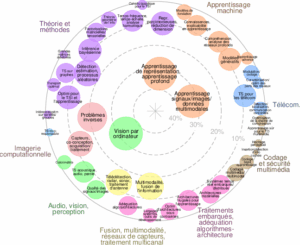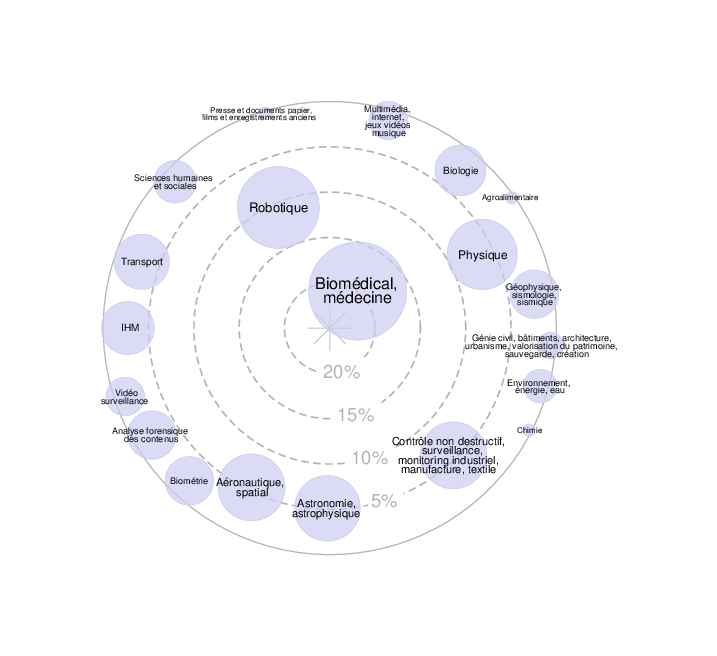Stage M2
This internship focuses on the imaging accuracy of synthetic aperture observation systems, in particular Synthetic Aperture Radars (SAR). It aims at establishing new imaging performance assessment tools, by using a parameter estimation framework. More than describing the inherent imaging performance, the indicators derived may serve as guides for the design of these systems.
Hosting laboratory: Laboratoire SATIE (location: ENS Paris-Saclay, 4 avenue des Sciences, Gif-sur-Yvette, France).
Keywords: Parameter estimation, synthetic aperture radar (SAR), computational imaging, array processing, mean-squared error, spectral analysis.
Supervisors: Lucien Bacharach (prenom.nom[at]ens-paris-saclay.fr) and Joana Frontera-Pons (prenom.nom1_nom2[at]onera.fr)
Dates:
- Reception of applications: until mid-February 2025 (Note: a delay of approx. 4 weeks is to be expected between the notification of application acceptance and the actual start of the work.)
- Duration: up to 6 months
- Starting date: before end of March 2025
PDF file of the proposal https://solenoide.satie.ens-paris-saclay.fr/index.php/s/poapTJjpHrtbzmn
Scientific context
Imaging systems are used in many scientific applications, like astronomy (optical or radio interferometry), remote sensing (SAR) and medicine (e.g., magnetic resonance imaging). A common characteristic of these systems is that they use a number of sensors distributed across space, in order to form images of their environment. It can be shown that the space domain in which the sensors are located corresponds to the Fourier domain (i.e., spatial frequencies) of the image. As a consequence, the imaging task essentially consists in performing an inverse Fourier transform of the sensor (or Fourier-domain) measurements. Aperture synthesis exploits displacements of the system’s sensors and consequently virtually enlarges its aperture, resulting in an enhanced image resolution [1]. In SAR imaging, the system includes one or several transmission and reception antennas embedded on an aircraft, that typically follows a rectilinear (or sometimes circular) trajectory [2]. In radio astronomy, radio telescopes are arrays of antennas which include up to several thousands of antennas distributed on the Earth surface. For instance, the Low-Frequency Array (LOFAR) comprises over 50 000 dipole antennas spread across several European countries, and the Square Kilometer Array Observatory (SKAO) is an upcoming radio telescope that will include more than 130 000 individual antennas [3]. While these orders of magnitude will allow unprecedented imaging quality, they also raise issues regarding management of huge amounts of data and optimal resource allocation. To address such issues, a fundamental point is to be able to accurately assess the imaging performance of these systems [4].
Proposed work
For this internship, we propose to study the imaging capabilities of a SAR system by adopting a statistical estimation point of view, using a parametric model linking the data collected by the instrument with unknown parameters of interest. In this case, the unknown parameters include reflectivity of the objects in the observed scene and their locations, as described in [5]. The statistical performance of estimation procedures are usually assessed in terms of bias and variance, or mean-squared error (MSE). Obtaining these is a difficult task in general, in particular when the estimators cannot be derived in closed form, and thus requires computationally costly Monte-Carlo simulations. As an alternative, we propose to resort to bounds of the variance or of the MSE, such as the Cramér-Rao bound [6]. The work of this internship will then consist in the following steps:
- Study a relevant model for SAR imaging, and later on, for radio interferometry,
- Derive meaningful estimation accuracy indicators on the parameters of interest,
- Compare the proposed indicators with the performance of state-of-the-art estimation algorithms.
Results obtained may lead to formulate new tools and criteria for the design of synthetic aperture observation systems [7-9]. This work is expected to lead to the submission of a paper to a national or international conference in signal processing. At the end of the internship, an opportunity to go on with the preparation of a PhD with SATIE on signal processing for radio astronomy may also be proposed.
Expected profile and skills
This proposal is intended to Master level (M2 or equivalent) students in signal and/or image processing, with background in mathematics and statistics and abilities in scientific programming and computing (e.g., MATLAB, Python). Applications from students in applied mathematics, or in electrical engineering with particular interests in signal/image processing (estimation, detection, inversion, restoration, etc.) and imaging applications or spectral analysis are also welcome.
References
[1] R. T. Hoctor and S. A. Kassam, “The unifying role of the coarray in aperture synthesis for coherent and incoherent imaging,” Proceedings of the IEEE, vol. 78, no. 4, pp. 735–752, Apr. 1990.
[2] M. Soumekh, Synthetic Aperture Radar Signal Processing with MATLAB Algorithms. Wiley, 1999.
[3] A. R. Thompson, J. M. Moran, and G. W. Swenson, Interferometry and Synthesis in Radio Astronomy, 3rd ed., ser. Astronomy and Astrophysics Library. Cham: Springer International Publishing, Feb. 2017.
[4] S. J. Wijnholds and A.-J. van der Veen, “Fundamental imaging limits of radio telescope arrays,” IEEE Journal on Selected Topics in Signal Processing, vol. 2, no. 5, pp. 613–623, Oct. 2008.
[5] J. Li and P. Stoica, “An adaptive filtering approach to spectral estimation and SAR imaging,” IEEE Transactions on Signal Processing, vol. 44, no. 6, pp. 1469–1484, Jun. 1996.
[6] S. M. Kay, Fundamentals of Statistical Signal Processing: Estimation Theory. Upper Saddle River, NJ, USA: Prentice-Hall, Inc., Mar. 1993, vol. 1.
[7] M. A. González-Huici, D. Mateos-Núñez, C. Greiff, and R. Simoni, “Constrained optimal design of automotive radar arrays using the Weiss-Weinstein bound,” in Proc. of IEEE International Conference on Microwaves for Intelligent Mobility (ICMIM). Munich, Germany: IEEE, Apr. 2018, pp. 1–4.
[8] A. M. Elbir, K. V. Mishra, and Y. C. Eldar, “Cognitive radar antenna selection via deep learning,” IET Radar, Sonar & Navigation, vol. 13, no. 6, pp. 871–880, Jun. 2019.
[9] J. Wang, L. Bacharach, M. N. El Korso, and P. Larzabal, “A comparison of antenna placement criteria based on the Cramér-Rao and Barankin bounds for radio interferometer arrays,” Signal Processing, vol. 219, p. 109404, Jun. 2024.





